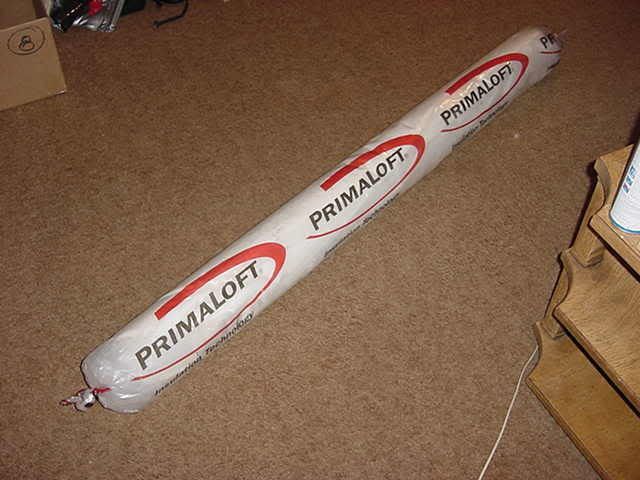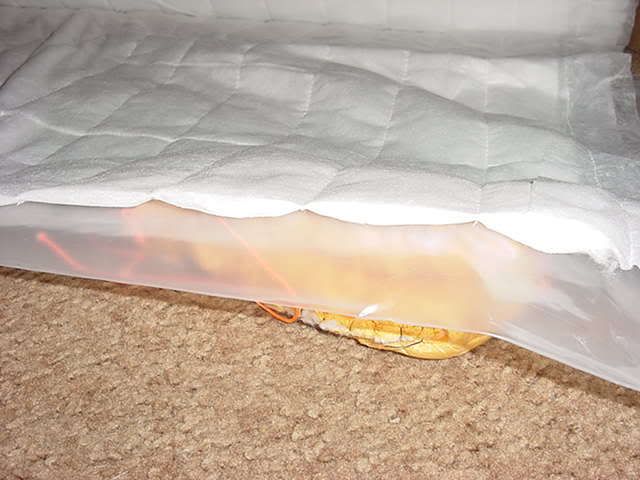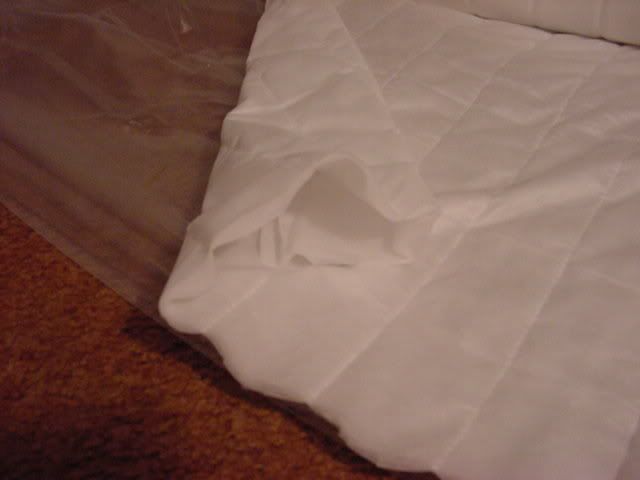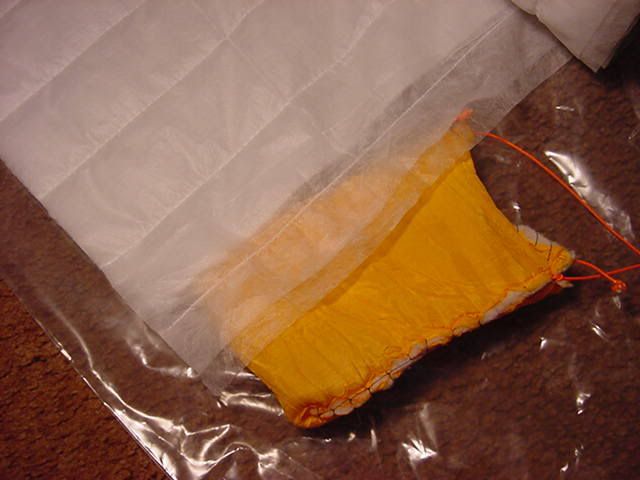Topic
Primaloft One – 1.8 per sq yard
Forum Posting
A Membership is required to post in the forums. Login or become a member to post in the member forums!
Home › Forums › Gear Forums › Make Your Own Gear › Primaloft One – 1.8 per sq yard
- This topic is empty.
-
AuthorPosts
-
Nov 10, 2006 at 6:59 pm #1220154
Primaloft One – 1.8
I received a sample of PrimaLoft One in the 1.8 ounce per square yard weight (stated weight) My first reaction is “boy that stuff is thin”. The clo for this product is 0.84. With the stated weight of 1.8 ounce I would have a clo of 1.51. The packing/compression size for the 1.8 ounce stuff has to be very small vs some of the other insulation I am working with. It looks nice but you can be the judge of that as you look over the pictures.
The first thing I make with the Primaloft One will be a Bivy Liner/Quilt. It will be the same size as the one I made out of Climashield Combat. I will run some tests and see if it is as warm as the Climashield Combat. The clo of the Climashield Combat in the Liner/Quilt I made was 1.59. This is just a small amount higher than the 1.51 clo of the PrimaLoft One.


 Nov 10, 2006 at 7:29 pm #1366778
Nov 10, 2006 at 7:29 pm #1366778Did they include recommendations for fixing/quilting it to the item? I got my wife a primaloft one jacket today and it’s interesting compared to a micropuff (PG delta).
Nov 10, 2006 at 8:02 pm #1366782As you can see from the pictures the PrimaLoft One is sewn every 3". When I make my first Quilt/Liner I will sew it with the 3" sewn part of the insulation on the width and see how it holds up. I will not quilt the insulation as it will only be 36" wide.
I am sending this from a Sony Store using a wireless UX Computer.Nov 10, 2006 at 8:39 pm #1366784Is that all insulation itself there or is it trapped between batting or something on the top and bottom. If you did a double layer maybe you could offset it and quilt it so you didn’t have the “sewn through” spot? Just curious as to construction methods used as down stuff is often baffled so you don’t have loft reduction in the highest end gear whereas this seems to be sewn through right from the factory.
Very cool that you got some!
Nov 10, 2006 at 9:39 pm #1366795The insulation is sewn between a layer of what is called “scrim”. It is called a “polypropylene carrier – scrim”. You can see in the picture that is it more or less transparent. The scrim on the 1.8 ounce insulation has the feel of silk.

The PrimaLoft One comes in 1.8, 3.0, 4.0, 5.0 and 6.0 ounce per sq yard weights. You can also buy it in what they call “pre-quilted” for an extra $0.81 per liner meter. I have no idea what that means but will try and find out.
I agree with the idea for a double layer and the over-lap or off-set method. If I did a double layer I would get a clo of 3.02.
Nov 19, 2006 at 8:36 pm #1367673Richard,
I am getting ready to made a Quilt / Liner out of the 1.8 oz PrimaLoft One. This one will be only for testing and will also use some of my light silk.
It will be made to use inside my Pertex Quantum / Cuben Bivy. In the other two quilts I have used light silk (0.57 oz per sq yard) for both the top and bottom layer of the Quilt. If I used Pertex Quantum instead of the silk would the Pertex Quantum add to the warmth of the Quilt? If yes, is the additional warmth enough to be worth using?
The difference in weight is 2.28 oz for the silk and 3.60 oz for the Pertex Quantum. The difference in cost is – I think Pertex Quantum would cost maybe 5 times more than the silk if you can get it.
I only want to use my Pertex Quantum where it will give me the biggest return.
Thanks.
Nov 19, 2006 at 9:32 pm #1367678Bill-The silk is fine.
The insulation value is effectively the same for both fabrics. Besides that, there is negligible insulation contribution from either fabric. All they do is protect the insulation and block forced convection (wind). Either one adds up to about .35 clo of insulation by virtue of the fabric being something for the air boundary layers to adhere to. The moisture absorption on the silk will be about 5% and the nylon 4.5%.
Nov 19, 2006 at 10:20 pm #1367681Thanks Richard,
I had been wondering about that for a long time.
Then I guess I could apply the same strategy to insulated body garments. As long as the outer most garment was made out of something more or less WPB when the weather required me to cover the silk item(s).
Using silk for the inter layers would let me make insulated garments for different temperature ranges without using as much of my Pertex Quantum on each item.
I may have so much Pertex Quantum left over that I can go into the SUL Bivy business.
Nov 22, 2006 at 9:07 am #1368013One thing to note is that I believe Primaloft requires the use of downproof fabrics… I’m pretty sure that lightweight silk is not quite downproof.
Nov 22, 2006 at 11:14 am #1368034Sorry Ben,
Your thought about my silk not being Down-proof is just wrong. I have been using two different weight silks (1.02 and 0.57 ounce per sq yard) for about 3 years. I use the best Down I can find and never less than 800 plus. A rare feather might get through my silk once in awhile but not enough to worry about. I get more feathers out of my WM Down Sleeping Bag than I do out of my Silk baffles.I expect NO problem using the same weight silk for PrimaLoft One or Sport. PrimaLoft come both pre-quilted and with a throw away scrim. I have some of both. The pre-quilted is really easy to work with and needs little more than sewing the outer edges to my shell material. The other needs a little more work according to which I am using but does not fall apart when handled.
I also have a PrimaLoft Product called PrimaLoft Footwear. You might look it up and think about the many possible uses for that one. I have a 5 yard by 60 ” wide piece of that one to work with.
Nov 22, 2006 at 12:08 pm #1368052I can imagine an garment with synthetic insulation, where one layer is made from less breathable fabric (pertex quantum) an d the other from something very breathable (silk was the inspiration, but very fine mesh could be used to make the effect stronger).
When the pertex is worn outside, it works just as an ordinary insulated garment. Turn it inside out to lower the insulation – air convection will cause the heat to leak easier.
Such a setup will also dry faster, and, finally, you may save some weight…Nov 25, 2006 at 6:10 pm #1368360Hey Bill,
Could you post a few pics of the pre-quilted P1.
The P1 you have pictured is a sewn-thru construction and should be used as a double layer so the sewn-thru lines would be in the center of the other.I am wondering if the P1 is strong enough to be self sustainable? For my unsupported record attempt of the JMT, I am looking for an insulation I can use as a layer in its self, without fabric on each side.
I would have a base layer, whatever I hike in, the insulation layer, then a WPB layer, (drop-stopper).The insulation would only need to last for 5 days and could have a skeletal fabric structure to hold it to the correct form.
If this could work, the weight of the gear without the fabric would be a great relief off of the base weight that would be carried 75% of the time any way.
The bottoms and top would need to be at least .6″ of loft or an equivalent clo. The bottoms would need to stand up to 35* temps with lite weight patagonia under and the drop-stopper on top. The top will be a short sleeve patagonia shirt and a railraiders l/s shirt on the bottom, the drop-stopper on top and a 40″ x 35″ 2.25″ loft down blanket on topI currently have a bottom made with .6″ Primaloft Sport and .85oz Ripstop. It comes in at 10 ounces, but without the fabric would be around 7oz. I am looking to get it to around 6oz and should be able to since the fit is too loose.
Bill, do you know if the P1 would work, or could you recommend which insulation would?
Nov 25, 2006 at 8:48 pm #1368370Aaron,
Q – 1. Could you post a few pics of the pre-quilted P1.
A – 1. The second and third pictures at the top of the thread are what PrimaLoft calls “Quilting is available from the factory for an additional $0.81/linear meter.” The material that is used for the quilting is called “carrier scrim”. It is a very thin Polypropylene material and is not very strong. I just did a tear test. Not good, it is not very strong. I don’t think it would last anytime if not covered with something.
====
I understand your quest for something very light. I played/tested a lot of different material to see what was “just” strong enough to work and last awhile when I was getting ready to make my SUL Quilts. The lightest silk I have is 0.40 ounce per sq yard 3 mm Silk Gauze and it is very hard to work with. I didn’t think it would work and went with 0.57 ounce per sq yard – 4.5mm Habotai, product number 21H, from Thai Silk. http://www.thaisilks.com.
What to make. I would use Climashield XP as it should be the easiest to work. I would then make three very simple items. One would be a pull-on Vest, the next would be a pull-on Jacket and the third would be a pair of very simple pants. I would use 4.5 mm Habotai Silk as the shell and liner for it all. Having two upper body insulation items give you great flexibility and added warmth if needed. It also should take you to your low temp goal but with two insulated items. If you are slick you might want to sew a hood on the vest.
Hoods are fun. I am putting hoods on everything. Like my old SW and LW Capilene shirts that open at the top.
PrimaLoft One needs to be stabilized every 6″ or so and would fall apart if you used it without a liner and shell. Sport is a little stronger and I have some. It is really nice but also would fall apart if used without a liner and shell.
Nov 25, 2006 at 9:36 pm #1368372Hey Bill,
Thanks for the insight on the Climashield XP. If it is any stronger than the Primaloft Sport it will work. I will more than likely just use the veil material on each side. It holds a stitch good enough and weighs next to nothing, (about .22 oz per yard), maybe even less.
I think I will make a double layer vest, maybe single on the back and a single layer separate arm system to attach to it. I already have a 1 oz bomber style beanie that works.After I make these and a new torso blanket, I will post the full packing list for the record attempt with pics.
The current list is shown on my user picture with my dog.My torrso blanket is just too small. The new torrso (scratch), half blanket will be made with Momentuim90 on top and .85 DWR on the bottom with 4 oz of 800 fill. I have a homemade 5.2 oz SpinnTex shelter I am going to use, so I can use the down blanket.
I don’t want to risk taking any down clothing without a larger tarp or bivy. Loosing that warmth in 35* rain would not make me a happy camper.
The down blanket however will have a cut for the head to be made into a wearable layer in case of high wind/ chill.Nov 26, 2006 at 12:40 pm #1368407Perhaps the need for a shell fabric could be avoided if the wadding had a ripstop pattern running thru it.
Dec 20, 2006 at 5:40 pm #1371780Hi Bill,
What kind of silk do you use that is downproof? Is it the flat woven china silk- habotai? I've used a light charmeuse before for a down travel pillow and it leaked feathers terribly. I usually get my silk from dharmatrading.com.
Thanks,
RoselleDec 20, 2006 at 7:06 pm #1371788Hi Roselle,
The question of "downproof and silk" really depends on the quality of the Down you use. I have always used Down from Thru-Hiker and that is what is in my Silk Down baffles. His Down is 800+. I ordered a pound of Down from him this afternoon. I really have never had a problem with Down migration using his Down. I think that is what its called. My standard has always been how much Down gets out of my WM Down sleeping bag. I can say that I get more Down out of my WM bag than I have with Thru-Hiker Down in my Silk baffles. I tried another Down supplier and it was OK but not as good or as easy to work with as what I get from Thru-Hiker.
My Silk comes from Thai Silks. I know about dharmatrading.com. I think I have been buying silk from Thai Silks for over 16 years. I do use their Habotai China Silk. It depends on how strong the item I am making needs to be for me to decide what weight Silk I use.
You have to understand when I say "my Down baffles" I am talking about long Silk tubes that I put the Down into. Those baffles/tubes were then used inside Poly Tubes to make Down Air Mattress. When I used the baffles/tubes in a sleeping bag type item the baffles were still put into a sleeve so I really had a double layer of material. For several years I keep one of my Silk tubes of Down hanging over the door into my computer room. Every time I thought about it I would grab the tube (78" long) and pop it much like you might a towel in a shower room. I never really got any Down out of the tube.
I am trying to make two more Synthetic Quilts and another Down Quilt before I leave for my hike in January. I believe I will use Pertex Quantum for both the liner and the shell for those quilts. I just finished a Down Quilt with 4 to 4.5 inches of loft and used Silk for all of it. The total weight of that Quilt with 12 ounces of Down is 17 ounces. It will go inside a Bivy so it will be protected from the weather. With the Pertex Quantum I don't have to be AS careful about the weather as I do with the Silk Quilts.
Dec 20, 2006 at 7:55 pm #1371792Hi Bill,
Thanks for your thoughtful reply. The down I had used was from a pillow. I'll have to experiment with the 800 fill. I was thinking something like epic for the outside, silk for the inside. I go backpacking with my daughter who is too young to carry her own bag, and too big to fit in mine. I'm getting sick of carrying 2 sleeping bags. So I'm thinking just carrying one, opened up as a blanket, with just silk underneath and our pads? Like the cocoon coupler. Or maybe a second one underneath, of synthetic fill that can be detatched. It would be for summer/tropical camping. We have warmer gear that I can't scimp on, but can go lighter on hawaii. (I hope to get to hawaii in the next year)
Jan 18, 2007 at 8:07 pm #1374851hey bill,
i am a fashion student and i'm collaborating with a friend of mine who also happens to be a bit of a mad scientist. We are planning to make a self heating vest for my roommate who works as a conductor on the freight trains. She will be exposed to high winds and cold temperatures. I've been doing some research and have found Prima loft to be the most suitable. There will be nickel batteries built in to the vest with wire running through the entirity of it. I was wondering if you knew where to acquire the prima loft as i went to the manufacturer and they wanted a business profile. If you could let me know where exactly you got it from that would be wonderful
Rebecca..
Jan 18, 2007 at 9:35 pm #1374855Hi Rebecca,
There are two places that I know of where you can buy – by the yard – PrimaLoft insulation. It will be PrimaLoft Sport but it is just about as good as the PrimaLoft One. Sport also is just a little easier to work with. It will not be pre-quilted.
One place is
Quest OutfittersThe other is
Thru-Hiker.comI don't know anyone that is retailing PrimaLoft One at this time.
Jan 20, 2008 at 6:25 am #1416840I dont know anything about silk, but am looking at the website Bill recommended. (www.dharmatrading.com)
It looks like the weights or thicknesses are from 5mm to 16mm… does anyone know what these numbers mean? I assume 5mm is the lightest weight, but does anyone know what any of these would equate to in weight/sq yd? I have no idea if the lightest weight would be too light or not… I may need to order swatches I suppose.Jan 20, 2008 at 6:32 am #1416841I can now answer my own question.
In case anyone else is wondering mm stands for momme. One momme is .13228 of one ounce. A square yard of 8 momme (8mm) China silk weighs one ounce.Jan 20, 2008 at 10:05 am #1416853Hi Peter,
I buy all my silk from ThaiSilks.com but you can get good silk from other places as well. I have bought other things from Dharmatrading.com. I have been buying silk from Thai Silks since about 1990 and have really been happy with them.
I am not sure where you got you weight for 1 mm, but my reference for it is 1mm =3.62 grams or 0.127 ounces.
That makes the 8mm = 1.025 ounces.
We are very close and the little difference isn't enough to worry about.
You can buy lighter weight silk but it is more like bug netting and is what I use for the bug net on my hammock. At Thai Silks it is listed under "Silk Chiffon", called "Silk Gauze". It comes in 3mm, 3.5mm and 4.5mm. This is really thin stuff and a pain to sew.
Jan 20, 2008 at 10:42 am #1416858Thank you for your reply Bill, I always enjoy reading about your projects.
I see where I got confused in the posts above, someone else asked about dharmatrading.com and you were responding. I will also check out thai silks.
My weight reference was from dharma trading.Jan 20, 2008 at 11:17 am #1416865I was curious about common perceptions of silk as a good bag liner fabric and why or why not..
I do not have any experience with the light silks other than seeing the various commercial bag liners in the stores.
Is there a perception silk is 'functionally' stronger (won't snag on dagger toenails) for the weight than a small denier heat calendered ripstop nylon? or that is is better at moisture management or drying, etc?
Would a 20d 1oz/sq/yd ripstop or taffeta nylon really be better?
Seems that a the key factor for a bag liner would be an air permability low enough to prevent excess heat escape but just enough to allow vapor to move thorough it.
Are these 8mm type silks as tight or a tighter weave than a Momentum or a Pertex Quantum?
-
AuthorPosts
- You must be logged in to reply to this topic.
Forum Posting
A Membership is required to post in the forums. Login or become a member to post in the member forums!
Our Community Posts are Moderated
Backpacking Light community posts are moderated and here to foster helpful and positive discussions about lightweight backpacking. Please be mindful of our values and boundaries and review our Community Guidelines prior to posting.
Get the Newsletter
Gear Research & Discovery Tools
- Browse our curated Gear Shop
- See the latest Gear Deals and Sales
- Our Recommendations
- Search for Gear on Sale with the Gear Finder
- Used Gear Swap
- Member Gear Reviews and BPL Gear Review Articles
- Browse by Gear Type or Brand.







